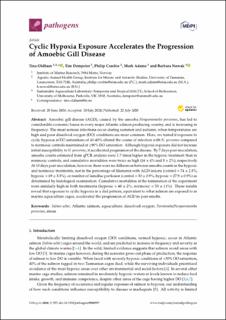| dc.description.abstract | Amoebic gill disease (AGD), caused by the amoeba Neoparamoeba perurans, has led to considerable economic losses in every major Atlantic salmon producing country, and is increasing in frequency. The most serious infections occur during summer and autumn, when temperatures are high and poor dissolved oxygen (DO) conditions are most common. Here, we tested if exposure to cyclic hypoxia at DO saturations of 40–60% altered the course of infection with N. perurans compared to normoxic controls maintained at ≥90% DO saturation. Although hypoxia exposure did not increase initial susceptibility to N. perurans, it accelerated progression of the disease. By 7 days post-inoculation, amoeba counts estimated from qPCR analysis were 1.7 times higher in the hypoxic treatment than in normoxic controls, and cumulative mortalities were twice as high (16 ± 4% and 8 ± 2%), respectively. At 10 days post-inoculation, however, there were no differences between amoeba counts in the hypoxic and normoxic treatments, nor in the percentage of filaments with AGD lesions (control = 74 ± 2.8%, hypoxic = 69 ± 3.3%), or number of lamellae per lesion (control = 30 ± 0.9%, hypoxic = 27.9 ± 0.9%) as determined by histological examination. Cumulative mortalities at the termination of the experiment were similarly high in both treatments (hypoxic = 60 ± 2%, normoxic = 53 ± 11%). These results reveal that exposure to cyclic hypoxia in a diel pattern, equivalent to what salmon are exposed to in marine aquaculture cages, accelerated the progression of AGD in post-smolts. | en_US |
